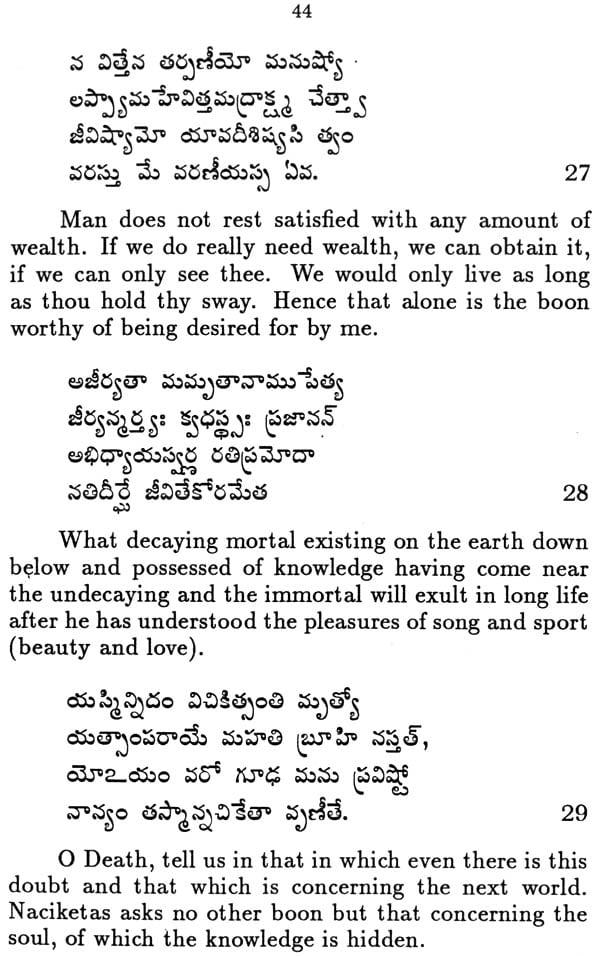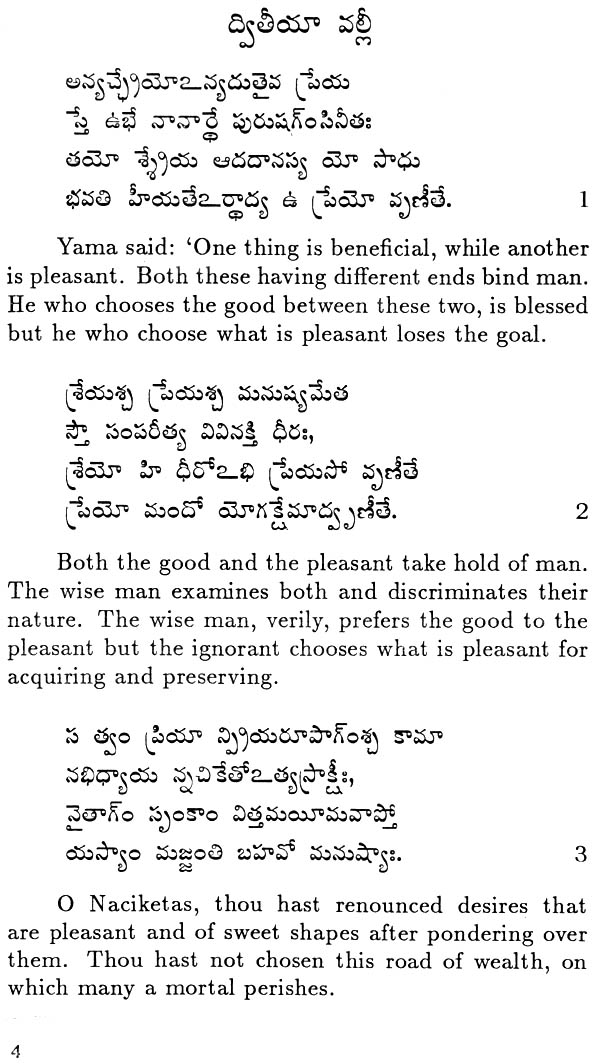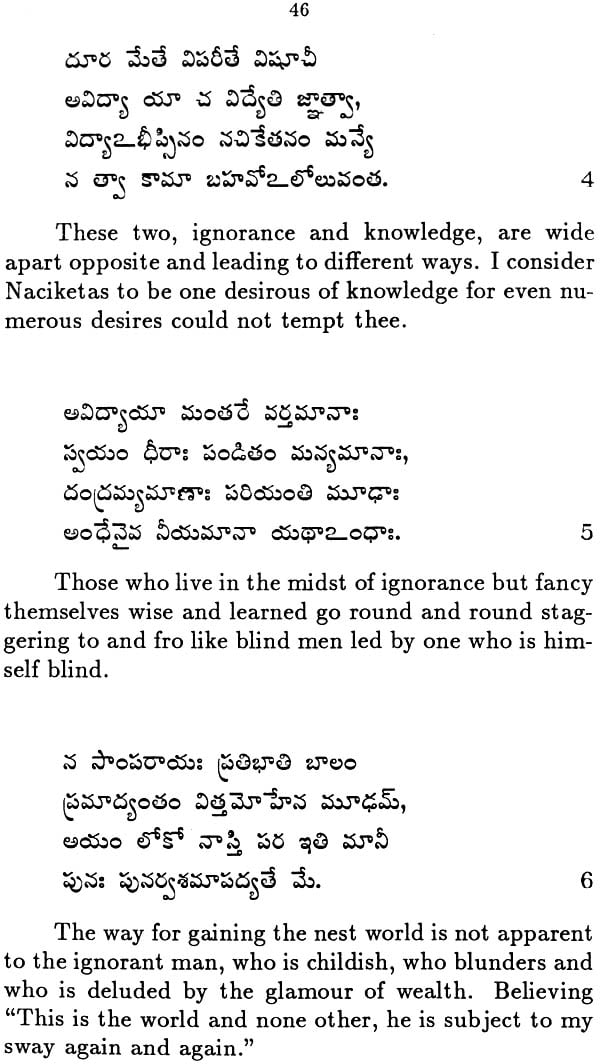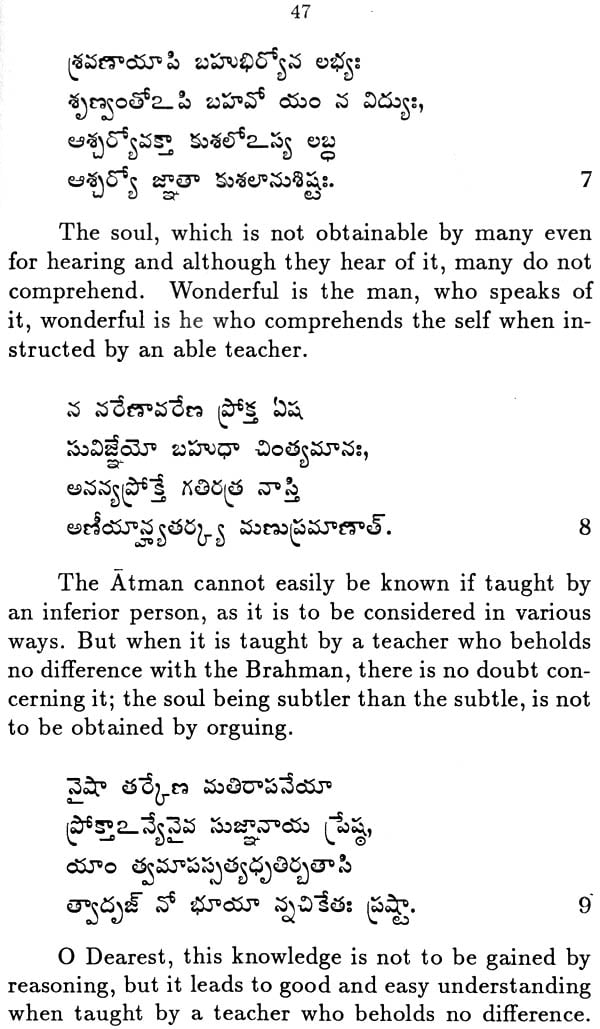
Upanishad Vallari
Book Specification
| Item Code: | NAL273 |
| Author: | P. Krishna Moorty |
| Publisher: | Tirumala Tirupati Devasthanams, Tirupati |
| Language: | Kannada Text with English Translation |
| Edition: | 2001 |
| Pages: | 91 |
| Cover: | Paperback |
| Other Details | 8.5 inch X 5.5 inch |
| Weight | 110 gm |
Book Description
About The Book
The Upanishads which reveal the intuitive wisdom of the great rishis are variously called as the Vedanta (the end of the Vedas), Vedasara (the essence of the Vedas) and Brahma Vidya (the knowledge of the Brahman). They constitute the jnana kanda portions of the Rig Veda, Yajurveda, Sarna Veda and Atharva Veda. All systems of Indian thought derive their sustenance and strength from the Upanishads, rightly termed the Himalayas of the soul. Among the Prasthana traya viz., Bhagavad Gita, Brahma Sutras and the Upanishads, the latter, therefore, enjoys a foremost place.
The present book contains a lucid translation of three principal Upanishads - Isavasyopanishad, belonging to Sukla Yajurveda, Kenopanishad, belonging to Samaveda and Kathopanishad of Krishna Yajurveda and also 'Atma Bodha' of Sri Sankara Bhagavatpada.
The Isavasyopanishad explains that the whole universe is the abode of Para Brahman and enjoins us to perform our duties with the sense of detachment and joy.
The Kenopanishad, conceived in the form of a dialogue between a teacher and a student states that only through spiritual knowledge one can realize the Parabrahma Svarupa, which exists beyond sensory perception. The very title of this Upanishad is significant as the word 'Kena' implies by which this universe ex- ists.
The Kathopanishad emphasises, through a dialogue between Nachiketa and Yam a the need for renunciation and sets forth the ways by which one can attain immortality.
'Atma Bodha' of Sri Sankara elucidates that the world of appearance is illusory and the Supreme self shines forth of its own accord when nescience is destroyed like the Sun when the clouds are dispelled.
Every Veda is divided into four parts viz., Samhita, Brahmana, Aranyaka and Upanishad. As the Upanishads come at the end of the Vedas, they are known as "Vedanta". The Upanishads have a prominent place in Indian philosophical heritage. Without understanding the Upanishads it is impossible to get near the core of Indian spiritual thought.
Upanishads uphold spiritual oneness of existence and give answers to the practical and theological questions of every thinker.
According to the tradition, 108 Upanishads are there. Among them Isa, Kena and Katha Upanishads have a prominent place. Sri Sankaracharya, however, took only ten Upanishads as authoritative and gave elaborate commentary on them. Isavasya Upanishad, Kena Upanishad and the Katha Upanishad find place among the ten.
Sri P. Krishna Murthy in this book rendered these three Upanishads into English. The translator had done a commendable job by translating the scriptures in a simple style to the benefit of common readers.
The "Atma Bodha", is written by Jagadguru Sankaracharya in the language of the heart, that we find in this text. The book also serves a need, that is felt by the seekers, who for some reason or other, have no opportunity to read the original, in Sanskrit. "Atma Bodha" emphasises self-realisation and recommends the ways and means for mukti.
We hope these English translations, of the sacred Upanishads and Sankaracharya's 'Atma Bodha' will be well raceived by the spiritual minded public.
As the spiritual experience of all men is imperfect, Truth revealed itself in this land through the minds of great Rsis. This revelation is Sruti which literally means what is heard. Great Rsis, who had perfected themselves by long tapas are said to have heard in their hearts eternal Truths and to have left a record of them in our sacred books called the Vedas. The Vedas consist of four parts viz. (1) Samhitas, Mantras or Hymns (2) The Brahmanas or explanatory treatises on mantras and rituals and (3) Aranyakas, the ritualistic prayers performed in the sacred forests, (4) the Upanisads or mystic treatises revealing the most profound Spiritual Truths and suggesting the ways of realising them.
The word Upanisad means "Sitting down-beside."
They embody esoteric spiritual knowledge meant for relection and contemplation and hence the deeper a man dives into the significance of these Scriptures in meditation, the greater the hidden meanings he finds in them. They are the sum and substance of all true wisdom. Some of them are written in prose and some in verse. They vary in length and form. According to tradition, Upanisads are 1180 one for each sakha of the Vedas but only 200 are brought to light and of them 108 are deemed worthy of study. Of these 108, only 10 have been recognised by Sankara as authoritative and wrote elaborate commentaries on them. They are (1) lsa (2) Kena (3) Katha (4) Prasna (5) Mundaka (6) Mandukya (7) Taitiriya (8) Aitareya (9) Chandogya and (10) Brhadaranyaka.
Isa Vasya Upanishat is a part of Sukla Yajurveda and is the shortest of all. It derives its name from the opening words of its first Mantra. This is Mantropanisad parexcellence as all the Upanisads that are in verse are so called. It tells us that whoever gets knowledge of the Supreme Soul finds everything identical with Brahman.









